Ceramic Rings: Affordable and Effective Bio Media – FishLab
Note: While this guide focuses on ceramic rings, the information is relevant to any ceramic-based aquarium filter media.
You know those white colored beads…
The ones that sit inside aquarium filters?
Well, those are actually ceramic rings.
And when used properly, ceramic rings provide powerful biological filtration for your aquarium – keeping your tank safe from dangerous chemicals!
Today, I’m going to teach you all about them.
What are ceramic rings?
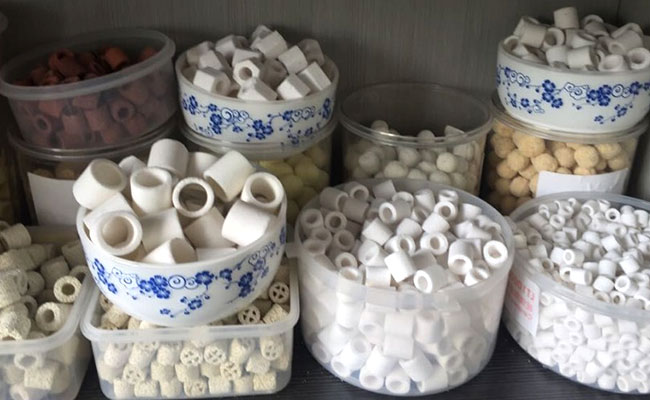
Sometimes referred to as bio rings, ceramic rings are unglazed pieces of fired ceramic. Most commonly, they resemble small white beads. However, they can also be found in other colors like cream, gray or brown.
Ceramic rings are designed to have an outer part that has lots of small holes, or pores, and a central hole that goes through the entire thing. This way, water not only runs over the ceramic rings but through them as well.
You might sometimes hear ceramic rings referred to as ceramic noodles because they closely resemble ditalini, a pasta with the same shape. Check it out…
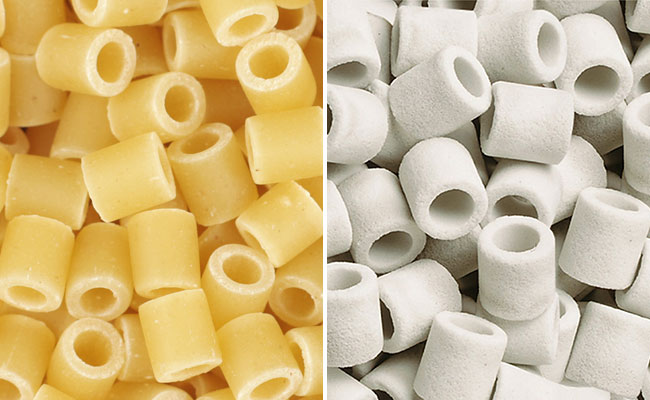
The left one is for eating. The one on the right? Shove it in your filter!
Confusingly, the phrase ceramic rings is often used to describe any ceramic-based filter media, regardless of the shape – round, square, even those without holes!
What are ceramic rings used for in your aquarium?
If you think back to the nitrogen cycle, you will remember just how important nitrifying bacteria are.
This beneficial bacteria removes ammonia and nitrites (harmful chemicals) from your aquarium. These chemicals naturally build up inside your aquarium, and if the bacteria in your tank don’t remove them, then your fish will eventually die. As you see, these beneficial bacteria are pretty important.
Well, these bacteria need a place to live. Ceramic rings offer the perfect home for the beneficial bacteria in your aquarium.
You see, beneficial bacteria need a surface to cling to. The more surface that is available, the more bacteria that your filter media can hold.
Ceramic rings increase their surface area through tiny little pores. These pores are so small that you can hardly see them without a microscope…
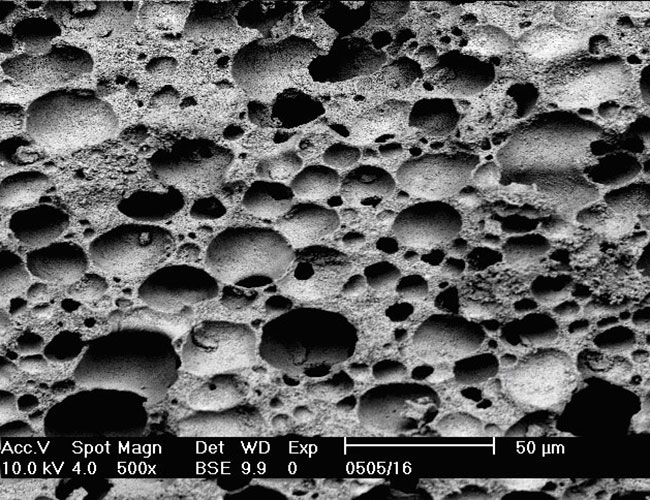
It’s in these pores that the beneficial bacteria make their home.
Important: Ceramic rings do not filter your water. It’s the beneficial bacteria that live in these rings that do the filtering. Any new ceramic rings you add to your tank will not have any bacteria on them.
Ceramic rings do not filter your water. It’s thethat do the filtering. Any new ceramic rings you add to your tank will not have any bacteria on them. Properly cycling your tank will encourage beneficial bacteria to grow on your ceramic rings.
However, ceramic rings have an additional advantage over other types of filter media…
Ceramic rings can hold a second beneficial bacteria:
Denitrifying bacteria.
These bacteria eat nitrates and will only survive where there is no oxygen present.
Denitrifying bacteria live deep inside rock, ceramic and other porous materials, where oxygen cannot reach them. You won’t find this bacteria in plastic or foam filter media.
However, just because denitrifying bacteria help to combat nitrates, it doesn’t mean that you can skip water changes.
How do you add ceramic rings to your aquarium?
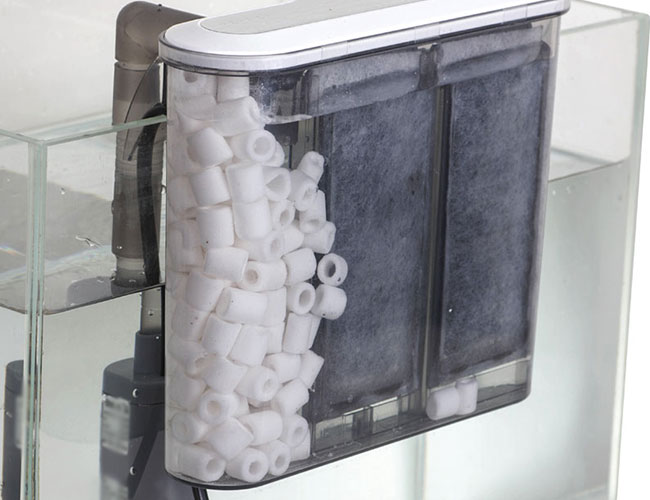
Using ceramic rings couldn’t be easier! Simply add them to your aquarium filter.
Many filter kits already include ceramic rings in the box. If your filter didn’t come with any ceramic rings, or you want to purchase more, grab some here or from your local fish store – they are very affordable.
While some ceramic rings come with their own filter media bag, others come loose. It makes no difference in performance if you choose to bag your ceramic rings or not.
I personally use a filter media bag since it makes it easier to remove the ceramic rings all at once, especially during cleaning.
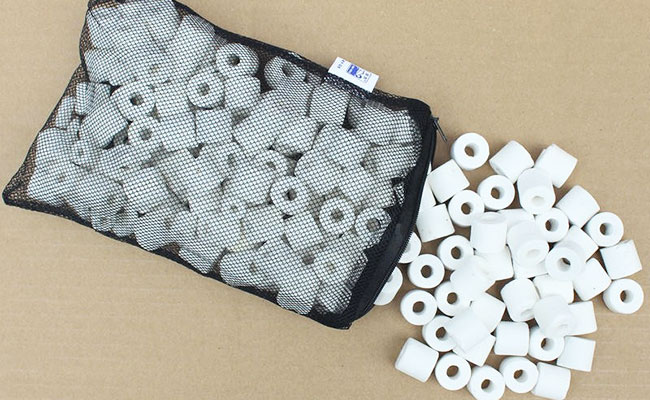
The first thing you want to do is rinse the rings in dechlorinated water. Doing so will remove any dust that built up from the ceramic rings rubbing together in the packaging. If you skip this step, the dust could cloud up your tank.
Next, you want to add the ceramic rings to your filter. And, the location is important!
You want your ceramic rings to sit after your mechanical filtration. Sponges, foam, filter floss, etc. should be the first thing that water passes through on its journey through your aquarium filter.
By placing mechanical filtration first, it catches any large particles such as fish poop, dead leaves and uneaten food, preventing your ceramic rings from gunking up.
Similarly, any chemical filtration, such as activated carbon or zeolite should be placed after your ceramic rings.
Important: Ceramic rings need to be kept submerged underwater at all times. The bacteria that live on the rings cannot survive out of water.
How many ceramic rings do I need for my aquarium?
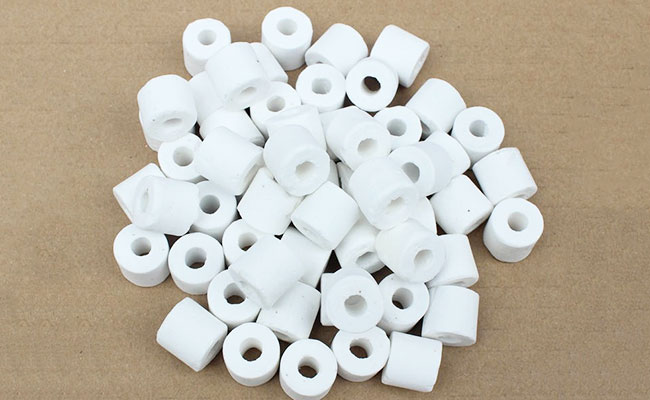
This is a surprisingly common question that I am asked.
Unfortunately, there is no set number – it all depends on the size of your aquarium.
The best answer I can give is…
As many as you can fit in your aquarium filter.
Filters are rated according to the size of your fish tank. Assuming you chose an appropriate aquarium, it should be able to fit all the ceramic rings you needed for good biological filtration.
If you have room to add more, then do it!
How do you clean ceramic rings?
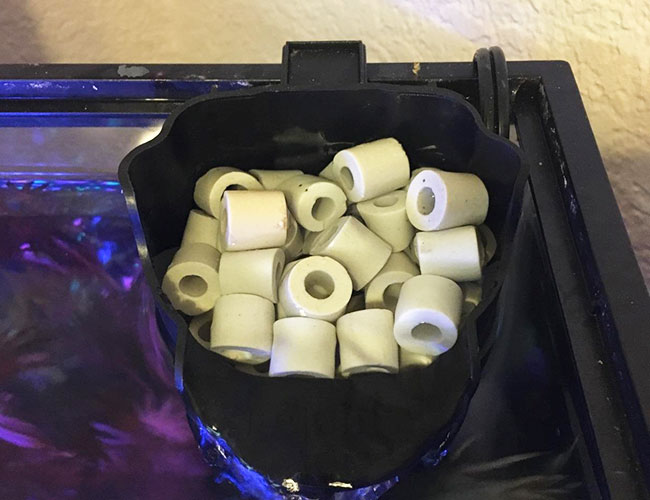
To provide effective biological filtration, it is important that water can easily flow around your ceramic rings.
Over time, you may notice that your ceramic rings begin to trap waste and restrict the flow of water through your filter.
If water cannot easily flow over your ceramic rings, then the beneficial bacteria that call them home are not going to be able to remove the nasty chemicals that are building up in your tank.
Fortunately, ceramic rings are super easy to clean.
The next time you perform a water change, add your ceramic rings to your bucket of siphoned tank water. Gently swish the water around to remove excess gunk.
It is important to note that you are trying to remove any excess waste that prevents water from flowing through them.
You are not trying to return your ceramic rings to the crisp, white color they were when you first bought them. If you do that, then you would remove the beneficial bacteria.
Your ceramic rings will still look ‘dirty’ once you finish, especially if they have been in your tank for quite some time.
Remember: Your ceramic rings are home to beneficial bacteria. These are living things! If you kill them, then your tank will need to be cycled again. Be careful and don’t expose them to soap, chlorinated tap water or scrubbing.
If you cannot clean your ceramic rings, then it might be time to replace them…
How often should I replace ceramic rings?
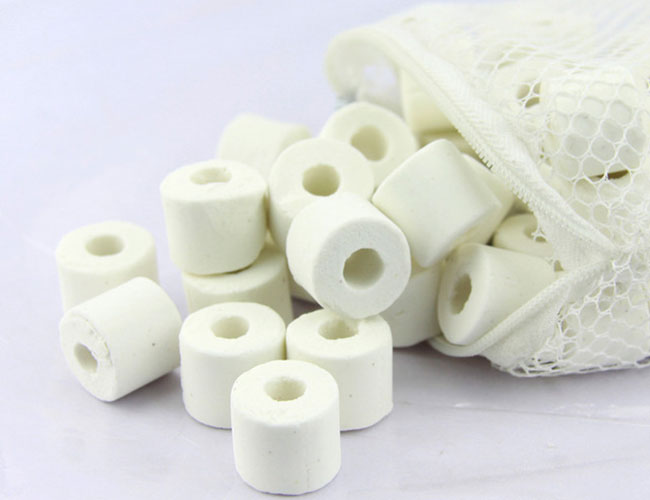
Exactly how often you should swap out your ceramic rings is the cause of much debate.
Even the manufacturers don’t agree!
Fluval, for example, recommends that ceramic rings be swapped out every 6 months.[1]
Marineland, another ceramic filter manufacturer, states that the rings should never be replaced.[2]
My opinion?
I sit somewhere between the two.
You see, your ceramic rings will eventually wear down. This is due to both the water constantly flowing over them and the ceramic rings rubbing against one another.
As I touched upon earlier in this guide, your beneficial bacteria need rough surfaces to cling to. And if your ceramic rings become smooth, then less beneficial bacteria can to cling to them and break down the harmful chemicals.
Now, don’t get me wrong. This entire process takes many, many years. One of my tanks has had the same ceramic rings (these ones to be precise) for nearly 3 years now, and my aquarium test kit reveals that my biological filtration is as good as ever.
So unless your ceramic rings have worn down or are breaking into pieces, there really isn’t any need to replace them on a regular basis.
If you need to replace the ceramic rings in your aquarium, then make sure you do it properly. Incorrectly replacing your ceramic rings could kill everything in your aquarium, which brings me to my next point…
How do I replace ceramic rings?
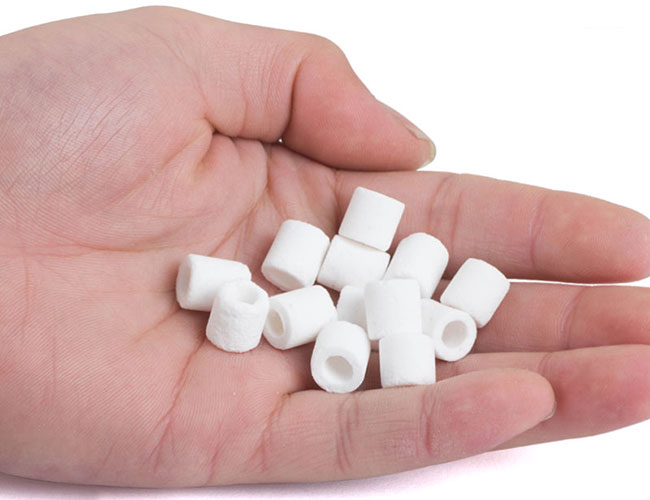
If you don’t take away anything else from this article, remember this:
Your ceramic rings are home to beneficial bacteria.
Yes, I know I keep repeating it, but it’s important!
You see… Your new ceramic rings will not have any beneficial bacteria living on them.
Now, this presents a bit of an issue. If you remove all your old ceramic rings and replace them with new ones, you would also remove most of the beneficial bacteria in your aquarium.
And without these beneficial bacteria, you will experience ammonia spikes, which can kill your fish.
So, the trick to changing out your ceramic rings?
Do it slowly!
Don’t remove all your ceramic rings at once. Take out half of your old ceramic rings and add half of the new ones.
This is why I like to use filter media bags. They keep your old ceramic rings and new ones separate.
What this does is encourage the bacteria to grow on your new filter media. This process is referred to as seasoning.
Leave the ceramic rings for two to three weeks before removing the remaining old ceramic rings and adding the rest of the new ones.
Make sure to keep an eye on your ammonia and nitrate levels throughout the entire process to ensure everything is going smoothly. An accurate aquarium test kit is your best friend in this situation.
You can also use this method to speed up the cycling process.
You see, ceramic rings in an established tank, meaning one that has already been cycled, will already be coated in beneficial bacteria. By adding these ceramic rings to a newly set-up aquarium, you can shorten the time it takes to cycle your tank.
Can I use ceramic rings inside my display tank?
While it’s not common, you don’t need to place the ceramic rings inside your filter to receive their benefits.
You see, established beneficial bacteria will begin to colonize your ceramic rings even if they sit in the main tank area.
With that said, beneficial bacteria still need a constant flow of oxygen and nutrients to live.
So if you want to go down this road, it’s a good idea to place your ceramic rings where they will have good water flow – such as directly under the outflow on your filter.
With that said, I don’t recommend using ceramic rings in your display tank. Without the mechanical filtration before them, they will clog much quicker.
What are the alternatives to ceramic rings?
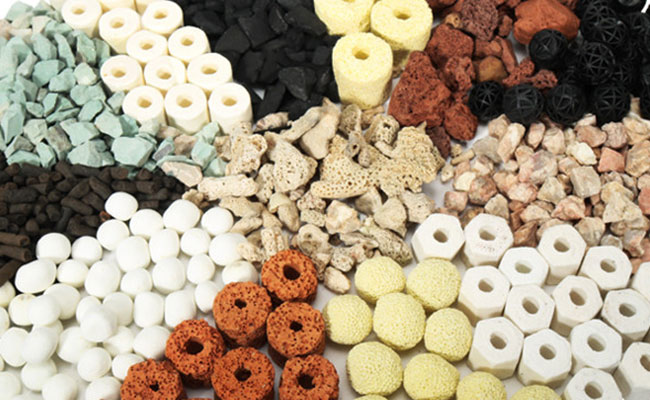
Ceramic rings don’t filter your aquarium. They simply provide a home for the bacteria that do all the hard work.
While there are other types of ceramic-based filter media, ranging from spheres to sticks, they all behave similarly to ceramic rings.
With that said, there are three other types of filter media that you can also use for biological filtration…
1. Bio balls
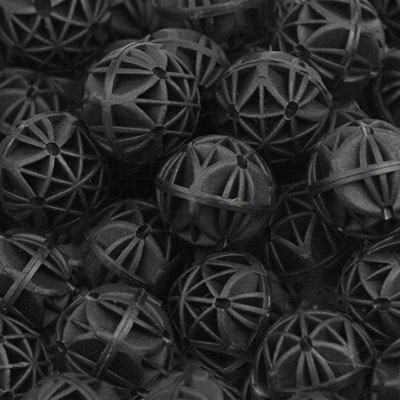
As the name suggests, bio balls are round pieces of plastic. These plastic balls have been designed to provide beneficial bacteria with many different nooks and crannies to call home.
Bio balls are typically used in larger tanks, refugiums and ponds, providing a cheaper alternative to ceramic rings.
Want more info? Check out our bio balls guide!
2. Sera siporax
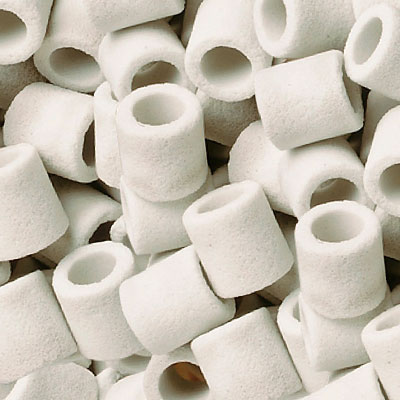
Sera siporax, which are very similar to ceramic rings but made from sintered glass, are small glass fragments that are heated and pressed together, leaving plenty of room for beneficial bacteria.
Siporax has about the same capacity for anaerobic bacteria as ceramic rings. However, my personal experience is that it wears down slower and is much less prone to breaking.
3. Lava rock
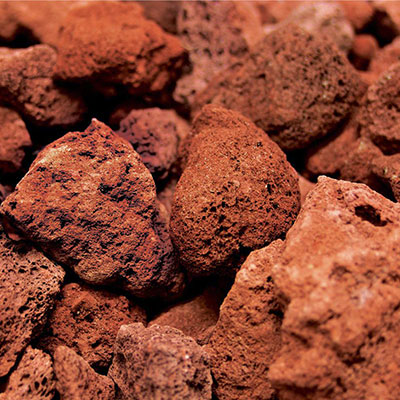
A natural porous alternative to ceramic rings.
Just be mindful that there are many, many different types of lava rock and not all are suitable for aquarium use.
You can either crush it up and put it in your filter bag or use it as a decoration in your main tank. Care should be taken if you use lava rock in your display tank because delicate fins can get snagged and scrapped.
Can I use ceramic rings in a saltwater aquarium?
Yes, you can. In fact, ceramic rings’ ability to hold denitrifying bacteria makes it a tempting option.
Despite this, ceramic rings are not commonly used in marine and reef tanks.
This is because saltwater aquariums have the ability to use live rock – which has much more room for denitrifying bacteria to grow.
Ceramic rings just can’t compete.
Any space in a saltwater tank dedicated to ceramic rings would be better filled with live rock!
Conclusion
Ceramic rings are one of the most popular methods of providing biological filtration to freshwater tanks.
Every tank needs biological filtration and ceramic rings are cheap, readily available and long-lasting.
Definitely a winner in my book.
Do you use ceramic rings in your aquarium? Let me know in the comments below!















![Toni Kroos là ai? [ sự thật về tiểu sử đầy đủ Toni Kroos ]](https://evbn.org/wp-content/uploads/New-Project-6635-1671934592.jpg)


